Galaktoboureko (Γαλακτομπούρεκο)
Galaktoboureko is a Greek classic dessert made with phyllo and a custard filling. The dessert is then soaked with a sweet syrup. The taste is mild, yet rich and sweet with a hint of cinnamon. The texture of the custard is smooth and creamy, with phyllo layers on the top and bottom of the dessert.
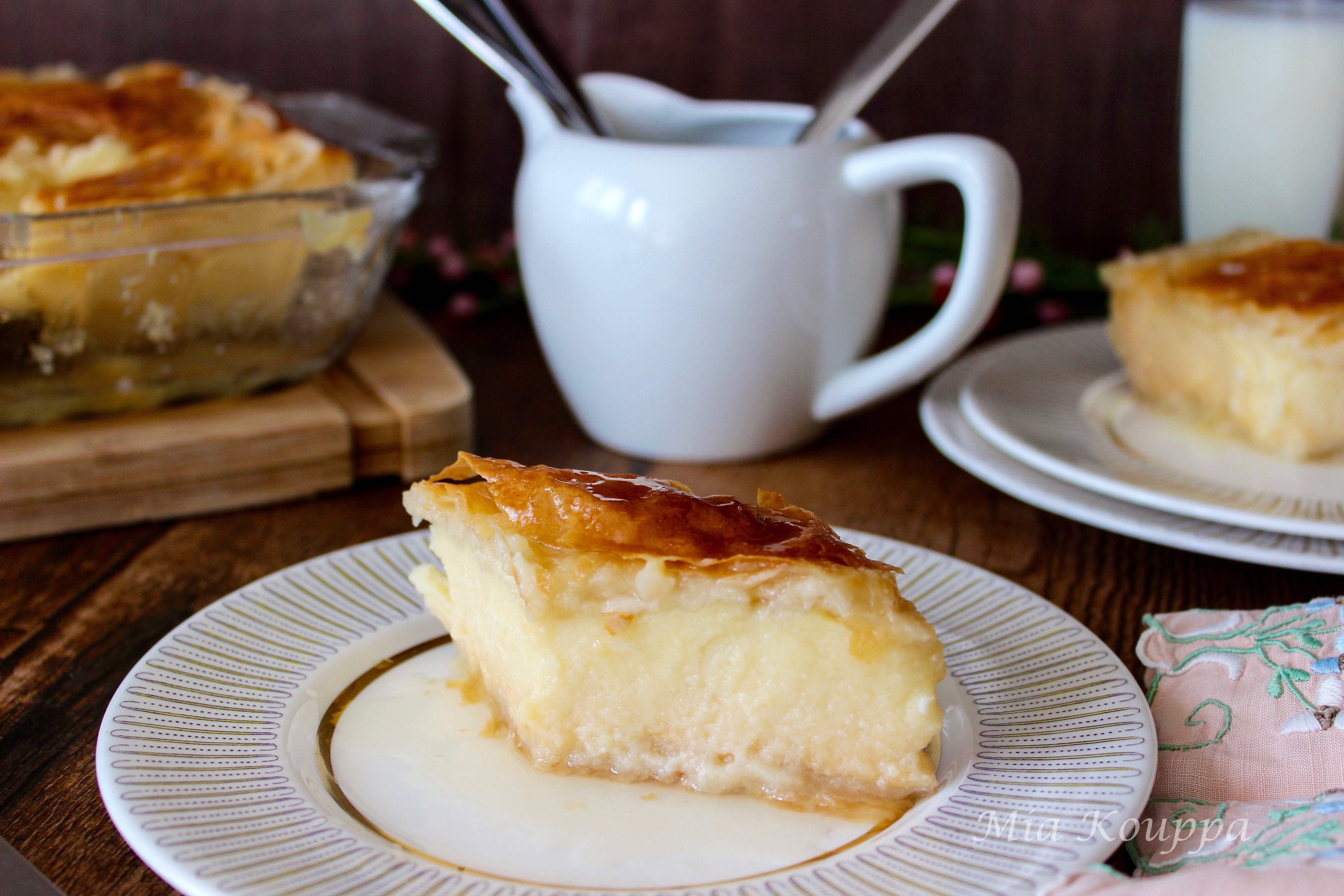
You know how sometimes things sound much more complicated than they actually are? This may be the case with this galaktoboureko recipe. I tried my best, but making this phyllo-encased, custard-filled, syrup-soaked dessert may read as though it would be very difficult, but fear not! In reality it is super easy….and oh, so worth it! I have added some extra pictures and videos to help illustrate the technique in case the words alone were too unclear.
Pin this recipe if you like it!
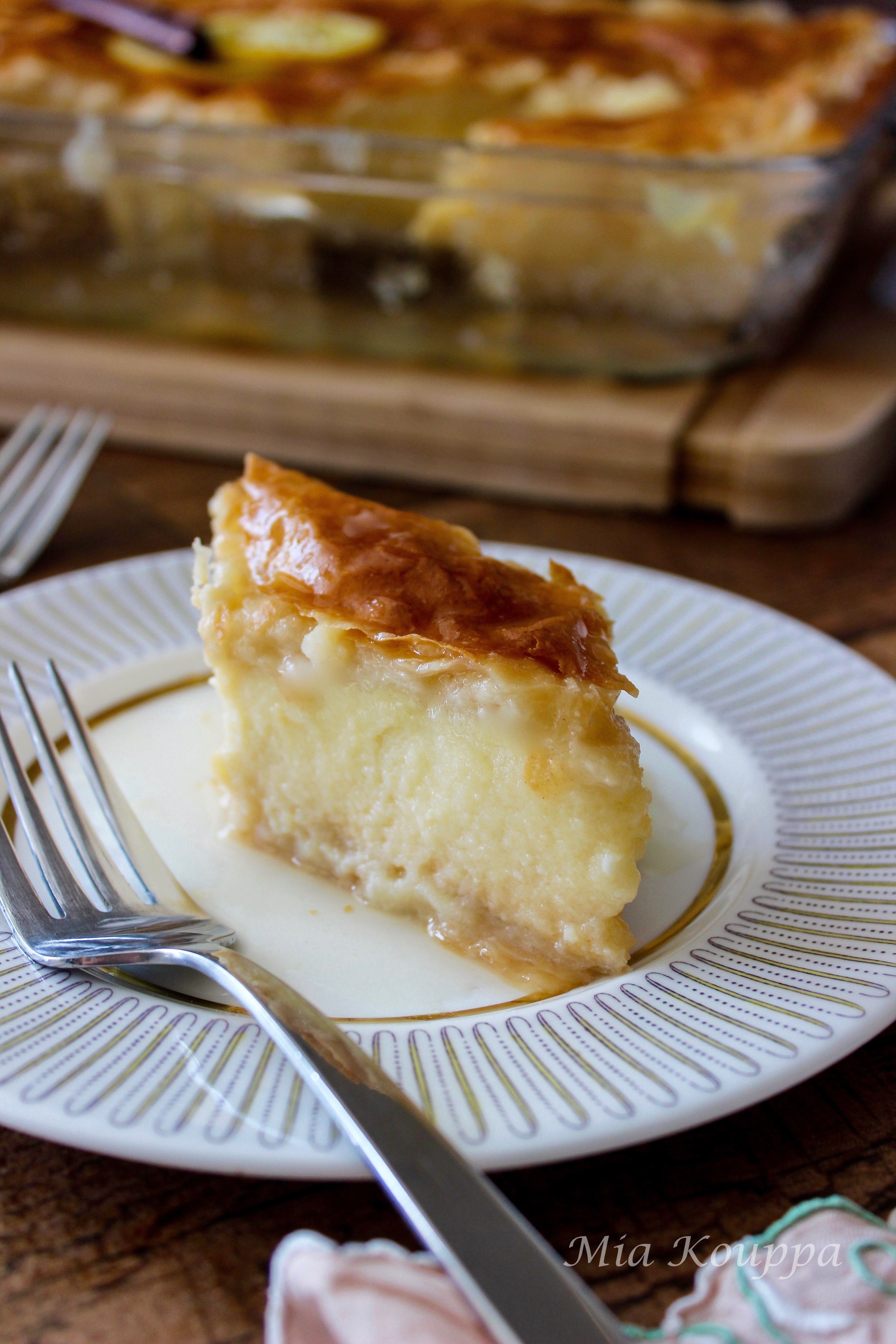
Why this recipe works
This galaktoboureko recipe is so good because the custard filling remains soft and almost luxurious. Unlike other recipes where the filling is firm and stiff, the filling here is the perfect texture. It is firm enough to hold its shape, but soft enough to be creamy and divine!
This recipe is a favourite in all of our family gatherings. In fact, it is my dad who perfected the art of making galaktoboureko. I learned to make it from him, and I am now so happy to share it with all of you.
Key ingredients
Making galaktoboureko is actually pretty simple and straightforward. You only need a few simple ingredients.
Phyllo dough – Sometimes referred to as filo dough, this is a paper thin dough that is made primarily with flour and water. I usually buy it fresh (in the refrigerated section of Mediterranean markets) but you can also find it frozen.
Milk – I have made galaktoboureko with full fat milk, lactose free milk, skim milk – every version has worked out pretty well.
Eggs – I use large eggs in this recipe
Semolina flour – Finely ground durum wheat helps to thicken the custard while also maintaining a smooth texture.
Butter – Unsalted butter is used
Sugar – White granulated sugar is used to sweeten the dessert but with a mild flavour. Sugar is used in the custard, but also to make the syrup.
Powdered vanilla – I love to use powdered vanilla because this is what my parents use when they are baking. It also does not change the colour of your dessert the way that a vanilla extract would.
Cinnamon stick – Gives the flavour of cinnamon without changing the colour or taste of the galaktoboureko.
Lemon slices – For a little added flavour for the syrup.
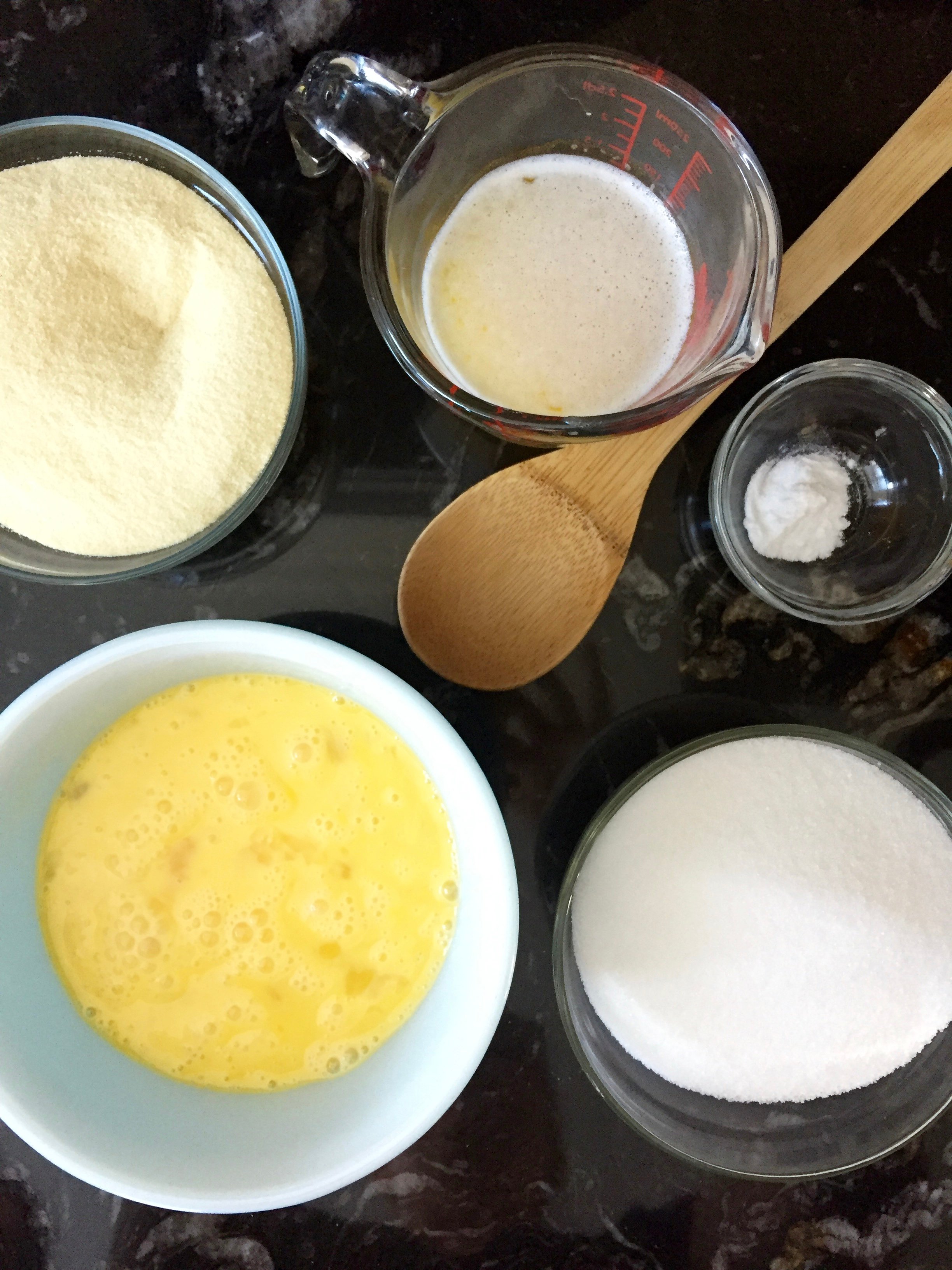
How to make it
Making galaktoboureko is really pretty simple if you follow my instructions. You will realize how easy it is to make a very impressive dessert that is a great way to end a traditional Greek meal (or any meal!)
Step 1
Preheat oven to 350 degrees Fahrenheit.
Step 2
In a large pot, over medium-high heat, combine melted butter and sugar. Mix until combined and then slowly pour in milk. Add semolina and vanilla. Cook for about 5 minutes, stirring occasionally.
Step 3
In a bowl beat together 6 eggs using a fork. Once thoroughly beaten slowly add them to the pot. At this point you must continuously stir the contents of the pot. Continue to cook, stirring constantly, over medium-high heat for about 10 minutes. The custard filling is done when it has the consistency of a pudding.
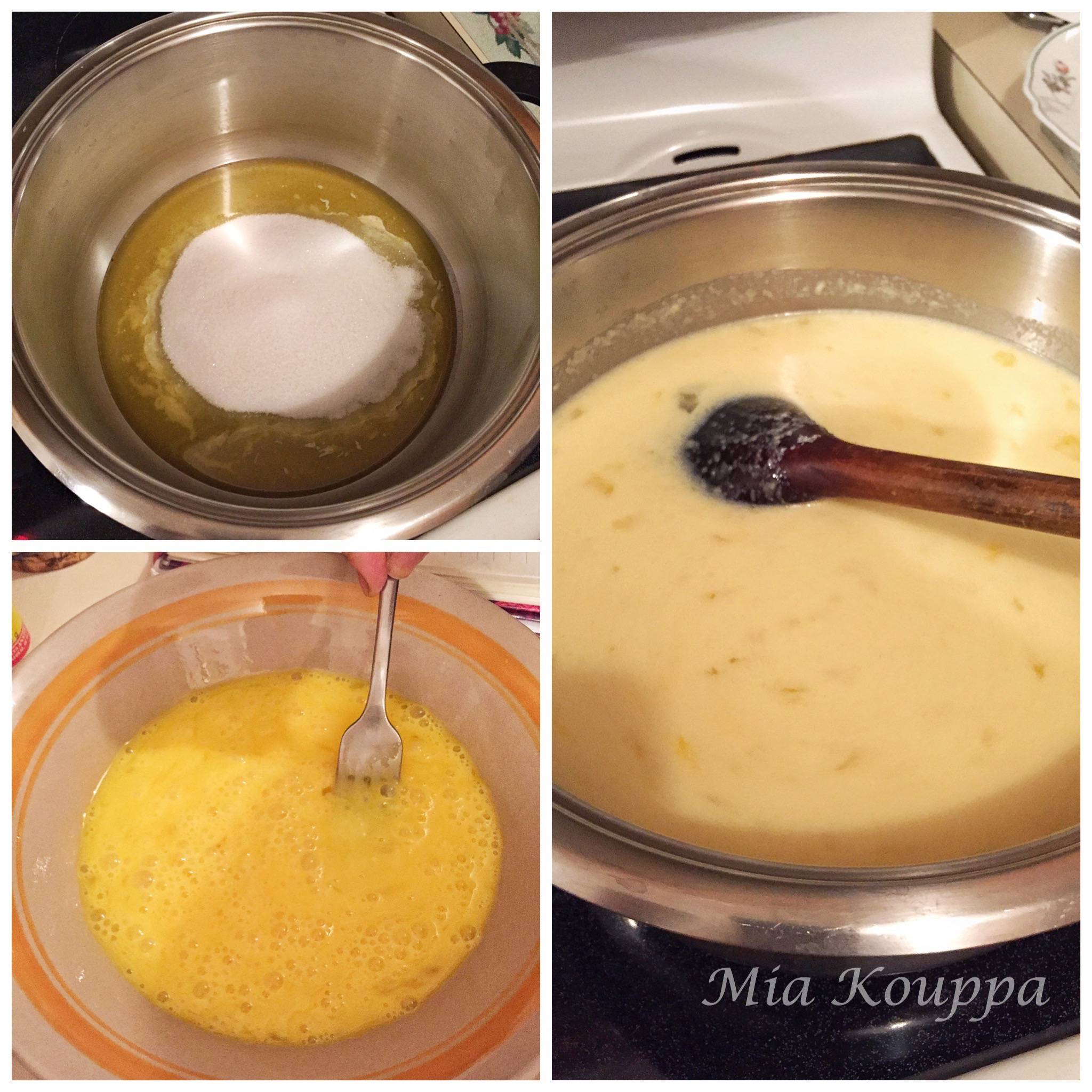
Step 4
If you are making this dessert with someone else, while you are stirring the custard, they could be preparing the phyllo dough. If you are doing this alone, simply remove the custard off of the heat and proceed to prepare your phyllo.
Step 5
Butter the bottom of a 9 1/2 x 13 inch rectangular baking pan. Place 2 sheets of phyllo on the bottom of pan. Your sheets of phyllo will be too large to line the bottom of the pan perfectly. This is good. Leave one end of the phyllo sheets hanging over the long end of your pan. Using a pastry brush, brush on some melted butter. When brushing the butter on the phyllo sheet do so lightly. The goal is not to saturate the phyllo with butter. Then, add two more phyllo sheets, this time letting the phyllo overlap on the opposite end of your pan. Brush on more melted butter. Repeat this entire process 3 more times so that you end up with eight times 2-layer phyllo sections. (So, to summarize, your bottom layer of galaktoboureko will be 16 sheets, with butter being applied between every 2 sheets, and with phyllo hanging over the two long sides of your pan).
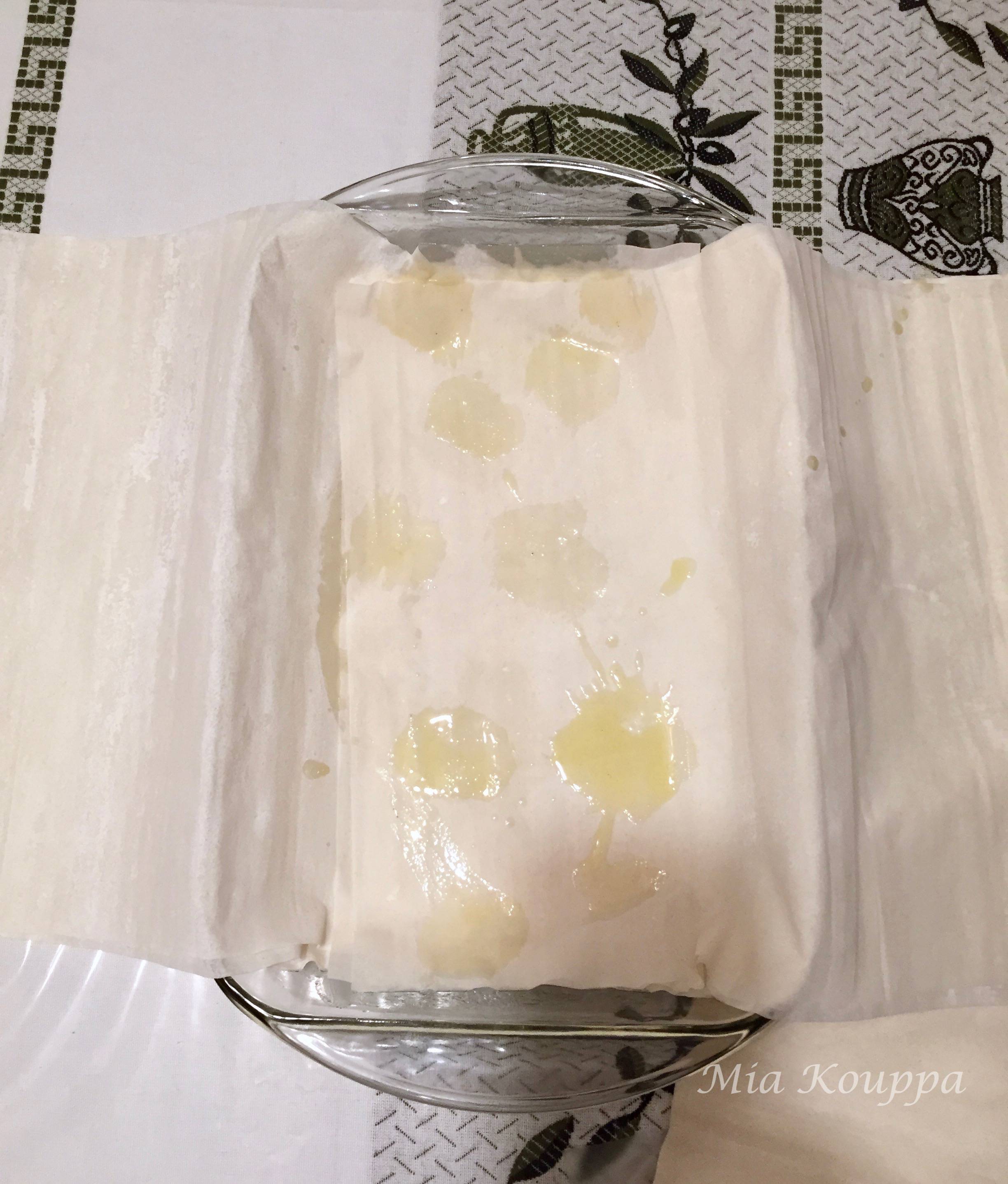
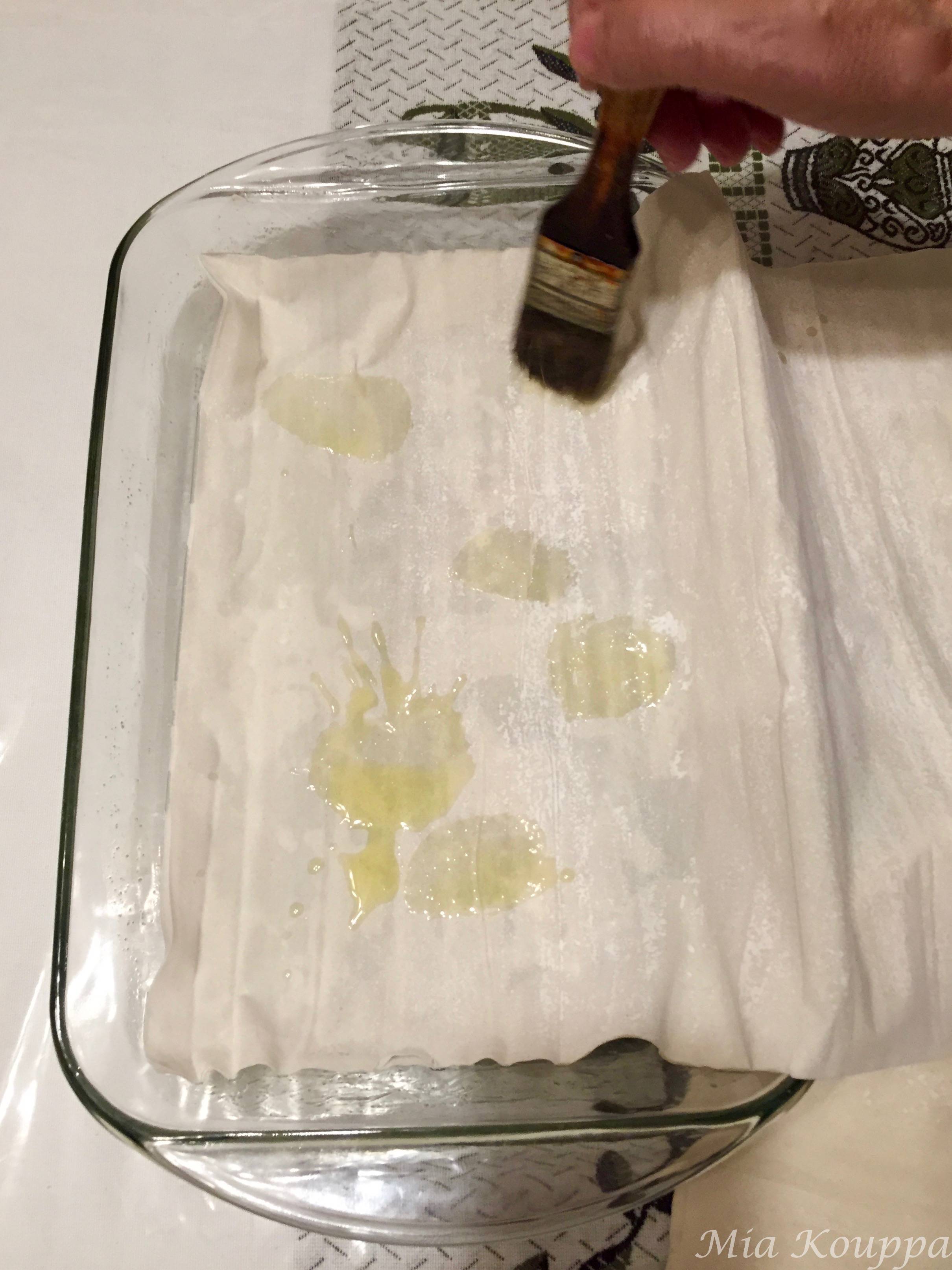
Step 6
Pour the custard mixture into the phyllo-lined pan. Spread it out evenly by using the back of a spoon. Now, take those overlapping sheets of phyllo, two at a time, and cover the custard with them, alternating sides. Remember to butter each set of two phyllo sheets before covering it with another layer of phyllo, as you can see here. When you have used up all of the overlapping phyllo sheets, take the phyllo that is still in the packaging, one sheet at a time, and fold it in half (or fold it in such a way that it fits the baking pan perfectly). Then, add this to the top of the galaktoboureko. Repeat this with at least 4 more sheets of phyllo, buttering between each sheet.
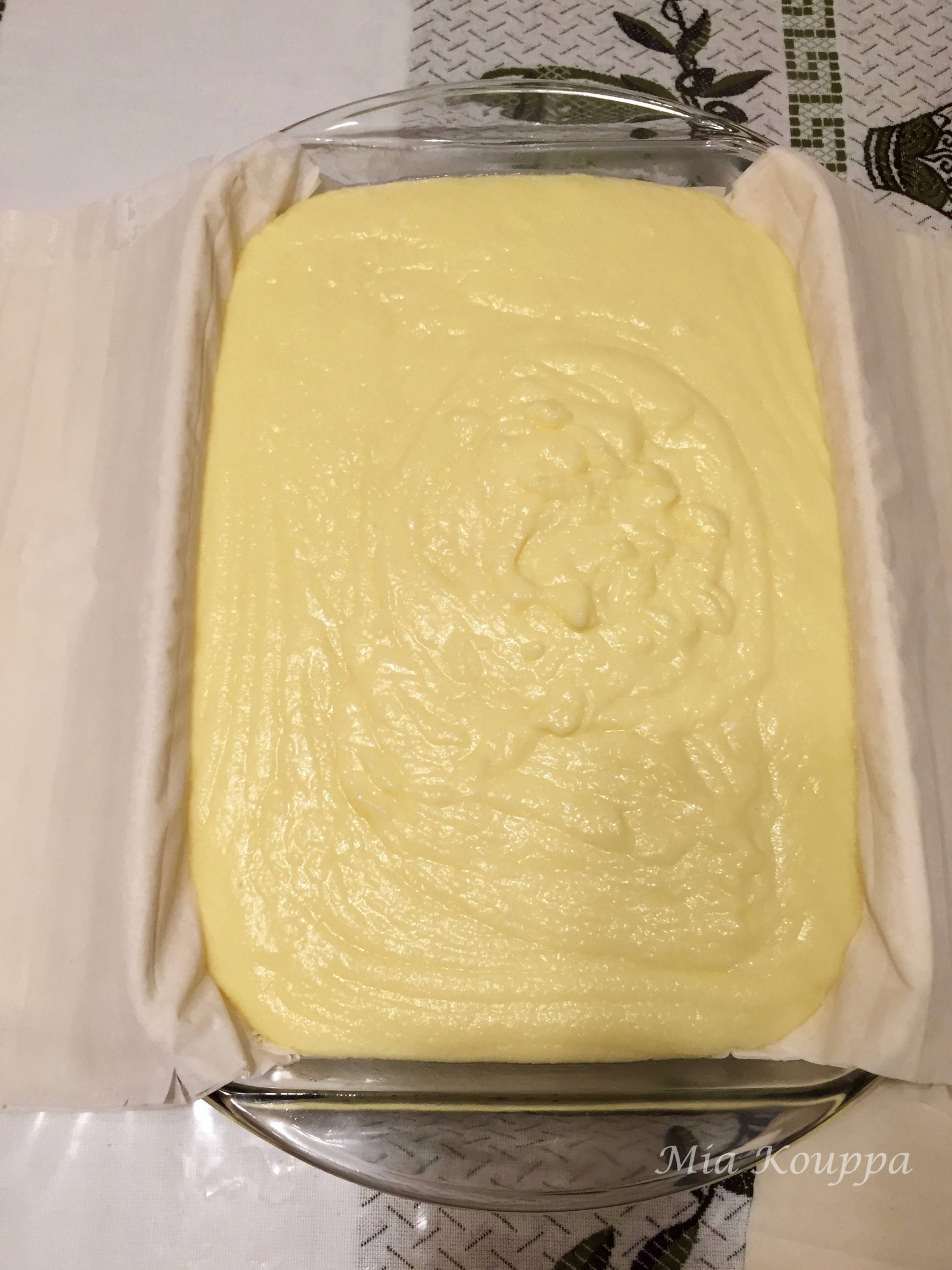
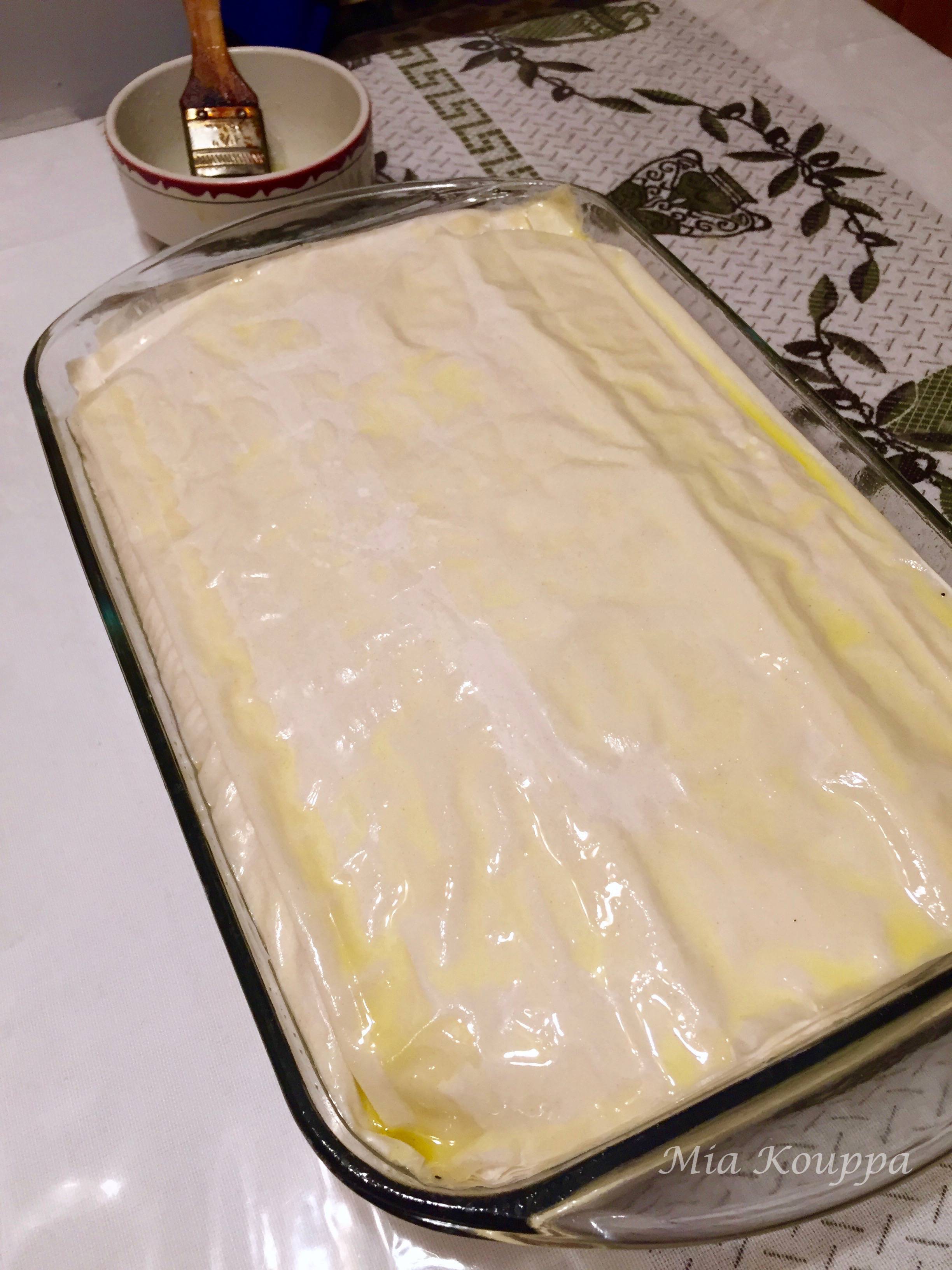
Step 7
Using a sharp knife score the top phyllo layers of the galaktoboureko 3 times lengthwise. Then, working along the 1st and 3rd lengthwise scores, create a bit of a herringbone pattern. This is not an exact science and in fact, the only thing you really need to know is that the vents you will create by scoring the phyllo will help it to bake properly and will be your guides when it comes to cutting out serving pieces.
Step 8
Place the pan in the middle rack of the oven and bake the galaktoboureko for approximately 45 minutes. You may need to rotate the pan mid-way through the cooking process depending upon how heat is distributed in your oven. You will know that your galaktoboureko is done when the phyllo is a lovely golden brown and slightly puffed up. Your custard filling will appear very loose when you remove it from the oven. This is normal and it will set as it cools.
For the syrup
Step 1
While your galaktoboureko is baking you can prepare the syrup. In a medium saucepan combine the water, sugar, cinnamon stick and lemon slices. Bring to a boil and once the sugar has dissolved reduce the heat and simmer for approximately 5 minutes. Remove from heat and allow to cool.
Step 2
When your galaktoboureko is done remove it from the oven and slowly spoon the prepared and cooled syrup onto it, while in the pan, letting each ladle of syrup to be absorbed. You can let your galaktoboureko cool slightly before doing so, but if you pour the syrup over it while it is still hot, you get this cool (but slightly messy) effect.
Step 3
You may find that you may not use all of the syrup. Use only as much as can be absorbed by the galaktoboureko.
Step 4
Allow your galaktoboureko to cool fully at room temperature before serving. Serving it while too warm, before the custard has set, will be messy (but still delicious).
Step 5
To store it, allow it to cool fully or overnight, before placing it in the fridge, where it will keep fresh (with the help of the excess syrup) for 4-5 days.
Frequently asked questions
What is galaktoboureko?
Galaktoboureko is a milk based dessert (gala means milk in Greek) which usually finds its way on any Greek dessert table, and always sweetens the end of our parents’ gatherings. For those of you who do not speak Greek, this dessert’s name can be a mouthful, which is okay because you likely won’t be pronouncing it correctly anyways. The Greek alphabet does not have a letter which makes the exact sound of an English “g”, and so the hard “g” used in galaktoboureko is the closest sound there is. The Greek letter gamma ( Γ γ) is a throaty sound, and similar to the noise you might make when trying to clear your throat of … okay, forget it. This is a cooking blog that risks becoming a little gross. Pronounce it anyway you like…no one will mind, especially if you’re the one making it!
Baking tips and helpful hints
Watch the video below for another one of our favourite Greek desserts: SAMALI
Working with phyllo dough
Phyllo dough (sometimes referred to as filo dough) has a bad reputation as being a finicky ingredient which is difficult to work with. Many recipes warn against the fact that it dries out quickly, tears easily and should therefore be handled with extreme caution. We say, hogwash! Sure, phyllo can dry up when exposed to air for a long time…but it has to be a pretty long time, longer than it will take for you to prepare this dessert, even for the first time. To help avoid the horror of dried phyllo however you can always cover, with a clean cloth, the phyllo you are not yet working with. And yes, it tears…but you know what…who cares? You will have to use several layers of phyllo dough for both the bottom and top of this dessert. If you have a few tears, no one will notice and it won’t effect your end product in the least. Just try to make sure that your top-most layers remain intact, for pretty purposes.
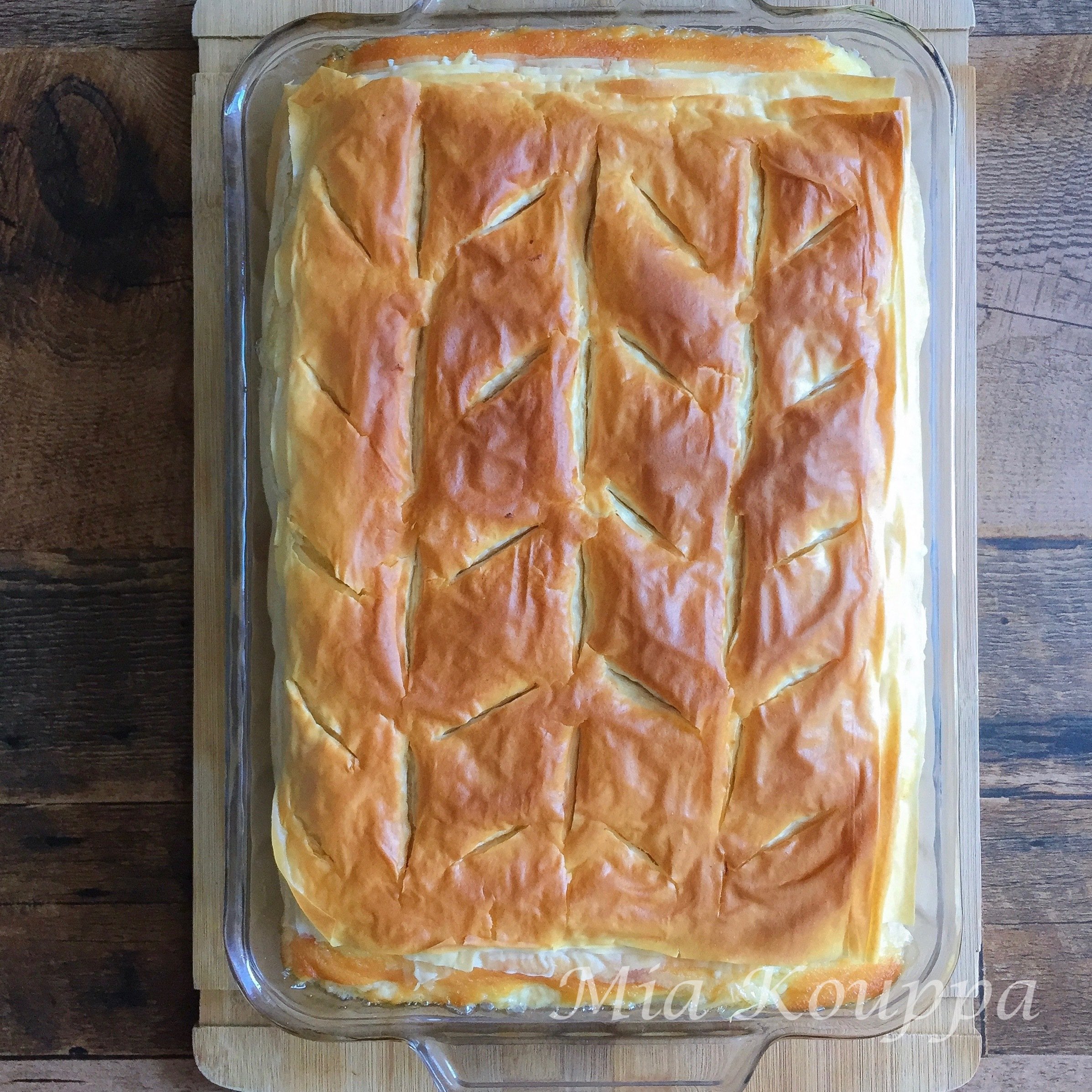
Where to find phyllo dough
You can find phyllo dough in pretty much any Middle Eastern or Mediterranean grocer, or any well stocked supermarket. It is often available both frozen and fresh. We prefer the fresh variety because we find the frozen phyllo sometimes gets a bit soggy after it has thawed. If the frozen phyllo is all you can find however, go for it!
Choose your semolina wisely
The type of semolina used in this dessert will affect the outcome (as I have found out). When recreating this dessert in my own kitchen, the end result looked a little darker and was just a little thicker than my parents’ galaktoboureko. After speaking with my folks and showing them my end result, their first question was, “What brand of semolina did you use?”. Seriously!? It seems that the brand, along with the type of semolina used, makes a difference. My parents only use the Monastiri brand of fine semolina, a product of Greece. If you can find this where you are, I suggest you use it. If not, then experiment with what you have on hand until you come up with a sweet which you love.
A glass pan is very helpful
My parents taught me to make galaktoboureko using a glass baking pan (lasagna pan). It is really helpful to use a glass pan as you can easily keep an eye on the bottom layer of your phyllo dough during the baking process.
A note about the custard
As you will see when you are reading the recipe, preparing the custard filling involves mixing beaten eggs into a hot milk mixture. When you pour the eggs in, it may appear that they are not blending into the milk mixture properly. You may see, for example, egg white which is not fully incorporated into the milk. If this is the case, don’t worry…it will all work out! Just keep stirring. However, if your eggs curdle (that is, if they cook and it looks like scrambled eggs) it IS a problem! This can sometimes happen if your milk mixture is too hot when you pour the eggs in, or if you do not stir continuously once the eggs are added. Don’t be too upset if this happens. As my mother says, if you don’t ruin stuff, you’ll never learn. In Greek this piece of kitchen wisdom and motherly advice rhymes (αν δεν χαλάσεις, δεν θα μάθεις), making it much lovelier.
How to store
Galaktoboureko is a perfect dessert for a crowd because one recipe will feed many sweet-teeth (we’ve decided that’s a word). If you are not making this for a gang of people, that’s okay too. Galaktoboureko will keep in the fridge for several days. Some people prefer to eat it cold, straight from the refrigerator, others at room temperature, and others like it warmed up for a few seconds in the microwave.
To store it, allow it to cool fully or overnight, before placing it in the fridge, where it will keep fresh (with the help of the excess syrup) for 4-5 days.
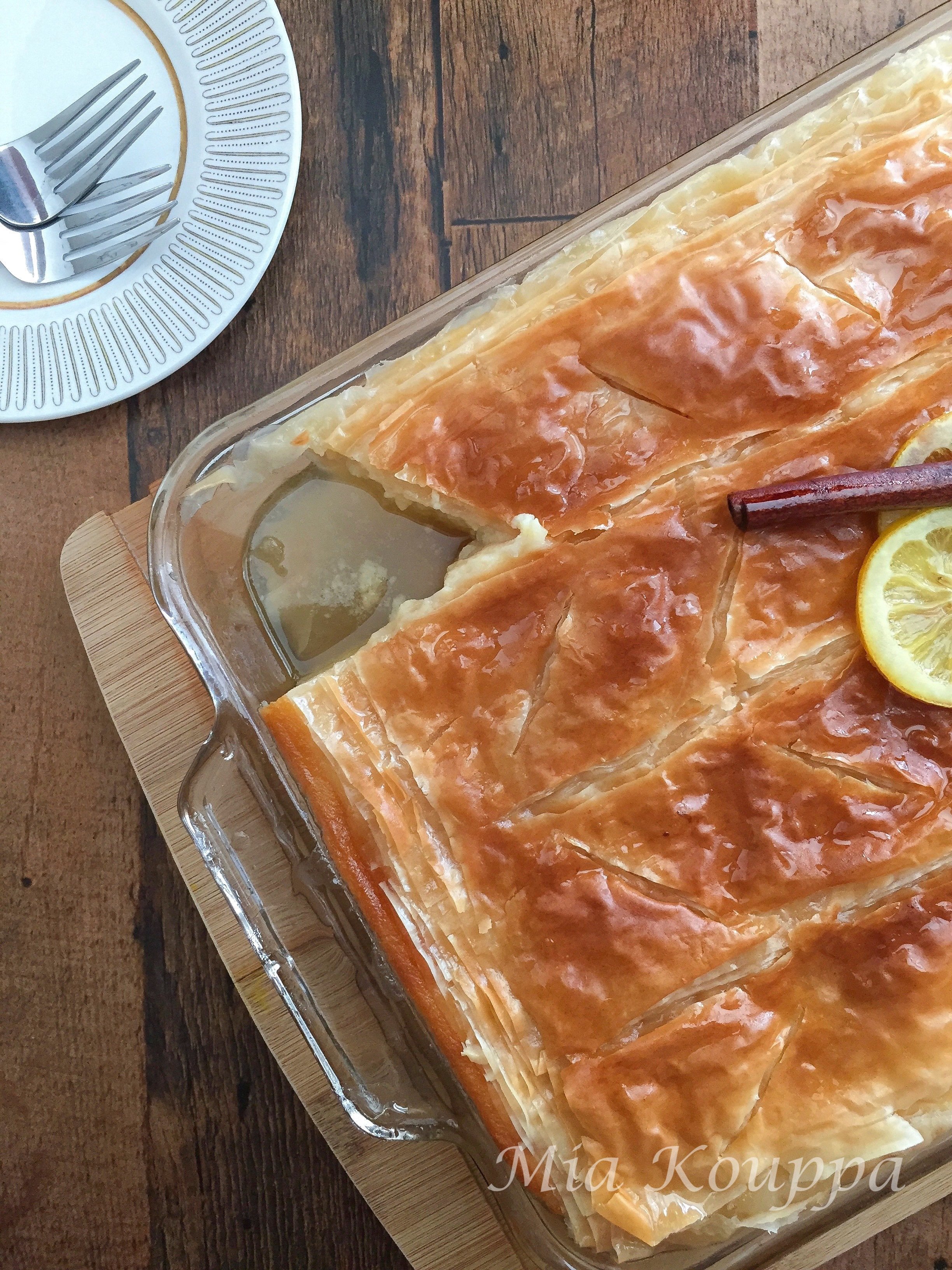
Recipe substitutions
Vanilla powder versus vanilla extract
My parents have used vanilla powder for as long as I can remember, so this is what I use here. If you cannot find vanilla powder, or prefer to use vanilla extract, use the same amount called for in the recipe. Keep in mind that most vanilla extracts are brown in colour and that this may slightly change the colour of your custard. If you don’t want to affect the colour you can purchase clear vanilla extract, usually found at baking supply stores.
Limit the dairy
This is a very dairy rich dessert, which some people may have a hard time digesting. You can easily substitute lactose-free milk if that helps, and perhaps you can even substitute the butter for margarine…but I’ve never actually tried that. If you do, let me know how it turns out!
Related recipes
If you’re looking for more classic Greek desserts, try these:
Baklava The traditional syrup soaked dessert made with layers of phyllo and crushed nuts.
Revani with coconut A light and moist cake made with coconut and soaked in a sugar syrup.
Portokalopita A classic Greek dessert where dried and crumbled phyllo dough is used instead of flour.
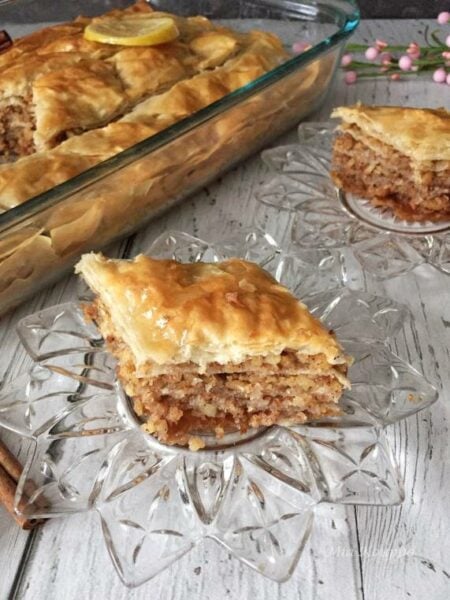
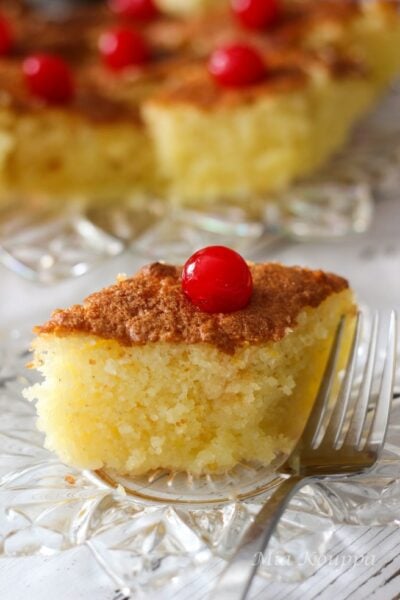
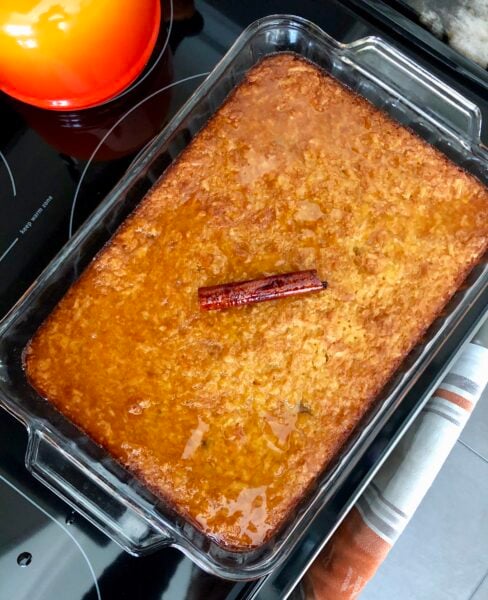
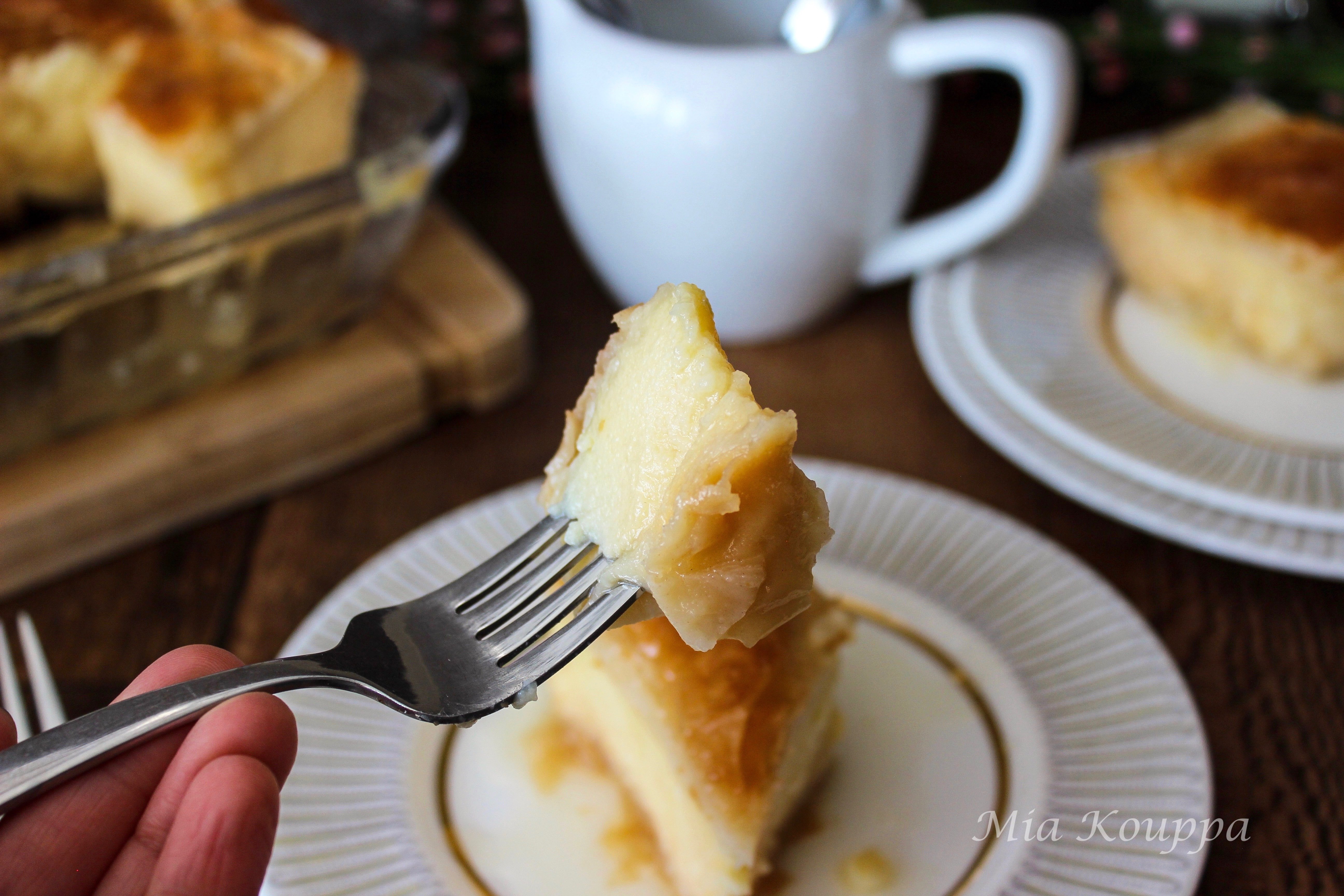
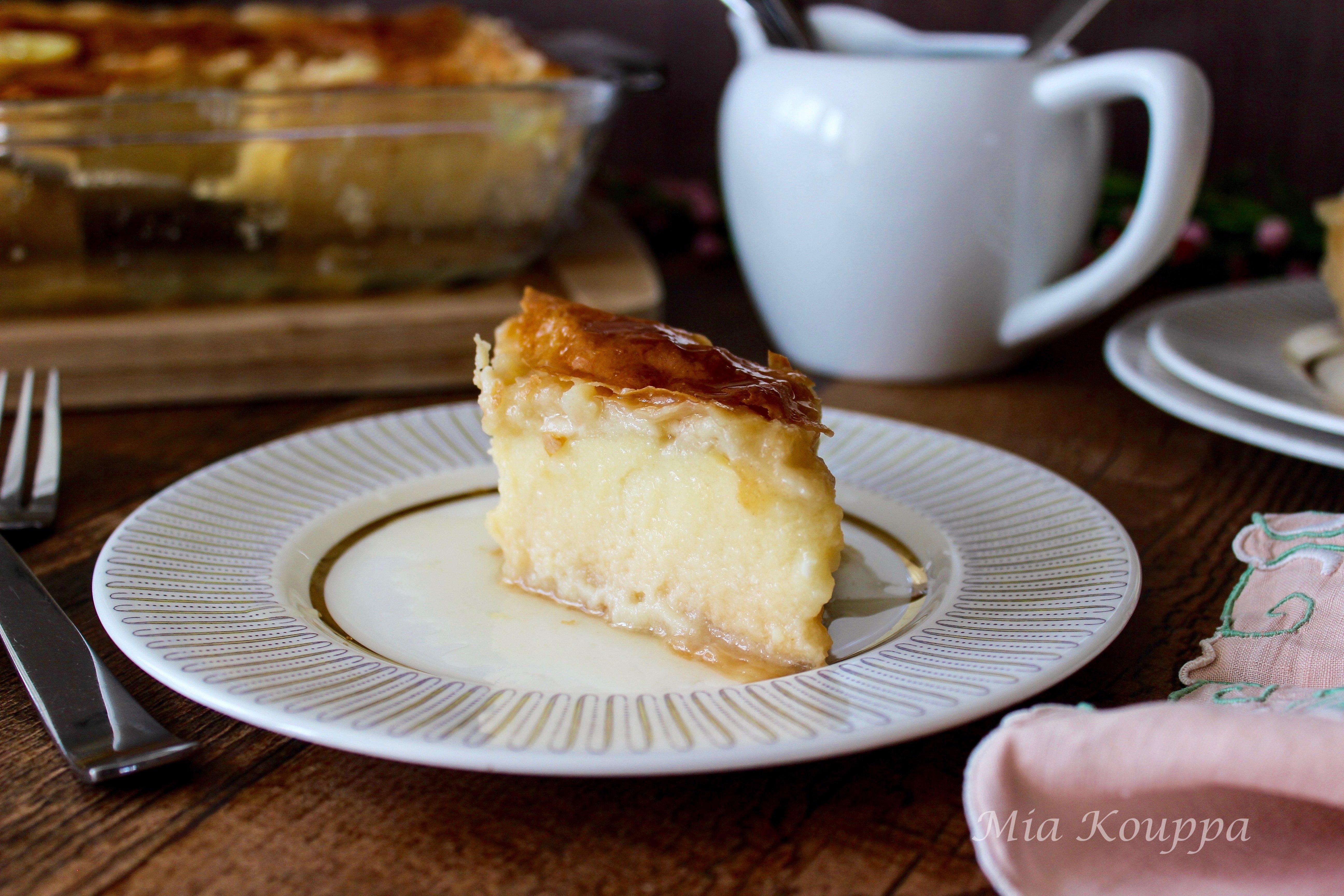
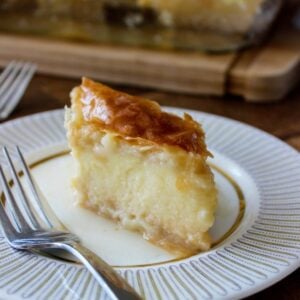
Galaktoboureko
Ingredients
- 1/2 cup melted, unsalted butter meaning you should end up with 1/2 cup (125 mL) after it is melted
- 1 cup granulated sugar
- 2 liters 2% milk
- 1 cup minus 1 tablespoon fine ground durum wheat semolina we like to use the Monastiri brand
- 6 large eggs
- 1/2 teaspoon powdered vanilla
- 1 pound phyllo (filo)
- 1/2 cup approximately melted butter for brushing onto the phyllo
For the syrup
- 2 ½ cups granulated sugar
- 2 cups water
- 1 cinnamon stick
- 2 slices lemon
Instructions
- Preheat oven to 350 degrees Fahrenheit
- In a large pot, over medium-high heat, combine melted butter and sugar. Mix until combined and then slowly pour in milk. Add semolina and vanilla. Cook for about 5 minutes, stirring occasionally.
- In a bowl beat together 6 eggs using a fork. Once thoroughly beaten slowly add them to the pot. At this point you must continuously stir the contents of the pot. Continue to cook, stirring constantly, over medium-high heat for about 10 minutes. The custard filling is done when it has the consistency of a pudding. You can get a sense of what it looks like here.
- If you are making this dessert with someone else, while you are stirring the custard, they could be preparing the phyllo dough. If you are doing this alone, simply remove the custard off of the heat and proceed to prepare your phyllo.
- Butter the bottom of a 9 1/2 x 13 inch rectangular baking pan. Place 2 sheets of phyllo on the bottom of pan. Your sheets of phyllo will be too large to line the bottom of the pan perfectly. This is good. Leave one end of the phyllo sheets hanging over the long end of your pan. Using a pastry brush, brush on some melted butter. When brushing the butter on the phyllo sheet do so lightly. The goal is not to saturate the phyllo with butter. Then, add two more phyllo sheets, this time letting the phyllo overlap on the opposite end of your pan. Brush on more melted butter. Repeat this entire process 3 more times so that you end up with eight times 2-layer phyllo sections. (So, to summarize, your bottom layer of galaktoboureko will be 16 sheets, with butter being applied between every 2 sheets, and with phyllo hanging over the two long sides of your pan).
- Pour the custard mixture into the phyllo-lined pan. Spread it out evenly by using the back of a spoon. Now, take those overlapping sheets of phyllo, two at a time, and cover the custard with them, alternating sides. Remember to butter each set of two phyllo sheets before covering it with another layer of phyllo, as you can see here. When you have used up all of the overlapping phyllo sheets, take the phyllo that is still in the packaging, one sheet at a time, and fold it in half (or fold it in such a way that it fits the baking pan perfectly). Then, add this to the top of the galaktoboureko. Repeat this with at least 4 more sheets of phyllo, buttering between each sheet.
- Using a sharp knife score the top phyllo layers of the galaktoboureko 3 times lengthwise. Then, working along the 1st and 3rd lengthwise scores, create a bit of a herringbone pattern. This is not an exact science and in fact, the only thing you really need to know is that the vents you will create by scoring the phyllo will help it to bake properly and will be your guides when it comes to cutting out serving pieces.
- Place the pan in the middle rack of the oven and bake the galaktoboureko for approximately 45 minutes. You may need to rotate the pan mid-way through the cooking process depending upon how heat is distributed in your oven. You will know that your galaktoboureko is done when the phyllo is a lovely golden brown and slightly puffed up. Your custard filling will appear very loose when you remove it from the oven. This is normal and it will set as it cools.
For the syrup
- While your galaktoboureko is baking you can prepare the syrup. In a medium saucepan combine the water, sugar, cinnamon stick and lemon slices. Bring to a boil and once the sugar has dissolved reduce the heat and simmer for approximately 5 minutes. Remove from heat and allow to cool.
- When your galaktoboureko is done remove it from the oven and slowly spoon the prepared and cooled syrup onto it, while in the pan, letting each ladle of syrup to be absorbed. You can let your galaktoboureko cool slightly before doing so, but if you pour the syrup over it while it is still hot, you get this cool (but slightly messy) effect.
- You may find that you may not use all of the syrup. Use only as much as can be absorbed by the galaktoboureko.
- Allow your galaktoboureko to cool fully at room temperature before serving. Serving it while too warm, before the custard has set, will be messy (but still delicious).
- To store it, allow it to cool fully or overnight, before placing it in the fridge, where it will keep fresh (with the help of the excess syrup) for 4-5 days.
- Enjoy!
Video
Nutrition

Unfortunately the custard was too liquid. Maybe it needed 4 whole eggs and 2 egg yolks? It didn’t set right.
Hi there! We’re sorry that the recipe did not work out well for you. The amount of eggs used in the recipe typically works out fine. Be sure that the eggs are large, and that you cook the custard for long enough. It should appear as it does in the video link found in the recipe. Hope that helps. Helen & Billie
For how many people would this recipe be?
Thank you.
Agnes
Thank you for asking the question Agnes – makes us realize we must update our post to reflect this information! This recipe will serve 24 pieces easily – not huge pieces, but a good portion. Hope that helps! xoxo Helen & Billie
Great recipe turned out delicious!!
Yay! So happy that you enjoyed it! Thank you for taking the time to let us know and for leaving a comment 🙂 Hope you continue to find much to love here with us! xoxo Helen & Billie
I am making this for the first time this weekend. I’d love to make it the night before. Can you clarify for me how to do this? I’m understanding bake it, then cool completely. Do I add syrup now, or the next day? Thanks so much!
Hi Nicole! We are so happy that you are trying our recipe – we think that you will love it! You have a couple of options – you can either make it entirely the day before (including adding the syrup), store it in the fridge and bring to room temperature before serving. Alternatively you can make the galaktoboureko the day before but not add the syrup. Then, the day of serving, bring the galaktoboureko to room temperature, make your syrup, and pour the hot syrup onto the galaktoboureko. In making any of the Greek siropiasta (syrup desserts) the general rule is that if your syrup is hot, your base is not. If your syrup is at room temperature then your cake or baklava, or galaktoboureko….. have to be hot. Hope that helps. Let us know how you enjoy the dessert! xoxo Helen & Billie
Thank you so much for helping me! Starting the cooking now!
Wonderful!!! Enjoy and let us know how you enjoy it 🙂 xoxo Helen & Billie
Hello Helen and Billie, I have followed your posts and recipes for a few years now. Everything you make looks delicious and I enjoy your stories. I have decided to make Galactoboureko for my Easter meal. I am not from your culture but I love Greek foods and they are always delicious. I think it will be perfect with my roast lamb shank. I was looking at recipes but then I thought I will check with Mia kouppa, they will know the BEST way. Thank you! So now I have read and studied and looked at your photos and I am READY. One suggestion: please put into phonetic the lovely Greek expressions you refer to such as the mother’s advice about kitchen mistakes. I love your language but the alphabet has me stymied. I will keep trying. But I love making the sounds. Christos Anesti!
Hi Carol! Thank you for your comment, and for your support and kind words. We are just thrilled that you are loving our website. How did the galaktoboureko turn out? We hope you loved it! And for the suggestion regarding the phonetic spelling of the Greek expressions – great idea. As we optimize and update our older posts we will fix that! Thanks again! xoxo Helen & Billie
Hi. How much vanilla extract do I substitute for the vanilla powder? I love your recipes.!
Thank you so much Rose! So happy to hear that you enjoy our recipes. A general rule of though is to use double the amount of vanilla extract (so, for instance, 1/2 teaspoon of vanilla powder = 1 tsp of vanilla extract). Enjoy! xoxo Helen & Billie